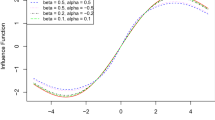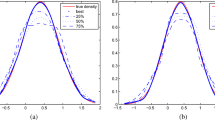Abstract
Indirect inference estimators (i.e., simulation-based minimum distance estimators) in a parametric model that are based on auxiliary nonparametric maximum likelihood density estimators are shown to be asymptotically normal. If the parametricmodel is correctly specified, it is furthermore shown that the asymptotic variance-covariance matrix equals the inverse of the Fisher-information matrix. These results are based on uniform-in-parameters convergence rates and a uniform-inparameters Donsker-type theorem for nonparametric maximum likelihood density estimators.
Similar content being viewed by others
References
F. Altissimo and A. Mele, “Simulated Nonparametric Estimation of Dynamic Models”, Rev. Econom. Stud. 76, 413–450 (2009).
R. Beran, Minimum Hellinger Distance Estimates for Parametric Models. Ann. Statist. 5, 445–463 (1977).
C. Berge, Topological Spaces (Oliver and Boyd, Edinburgh, 1963).
M. S. Birman and M. Z. Solomyak, “Piecewise-Polynomial Approximations of Functions of the ClassW α p ”, Math. USSR Sbornik 2, 295–317 (1967).
M. Carrasco, M. Chernov, J.-P. Florens, and E. Ghysels, “Efficient Estimation of General Dynamic Models with a Continuum of Moment Conditions”, J. Econometrics 140, 529–573 (2007).
R. M. Dudley, Uniform Central Limit Theorems, in Cambridge Studies in Advanced Mathematics (Cambridge Univ. Press, Cambridge, 1999), Vol. 63.
N. Dunford and J. T. Schwartz, Linear Operators. Part I: General Theory (Wiley, New York, 1966).
J. D. Fermanian and B. Salanié, “A Nonparametric Simulated Maximum Likelihood Estimation Method”, Econometric Theory 20, 701–734 (2004).
F. Gach, Efficiency in Indirect Inference, Ph.D. Thesis (Dept. of Statist., Univ. of Vienna, 2010).
F. Gach and B. M. Pötscher, “Nonparametric Maximum Likelihood Density Estimation and Simulation-Based Minimum Distance Estimators”,Working Paper, Univ. of Vienna. arXiv:1012.3851v1.
R. Gallant and J. Long, “Estimating Stochastic Differential Equations Efficiently by Minimum Chi-Squared”, Biometrika 84, 125–141 (1997).
C. Gouriéroux and A. Monfort, Simulation-Based Econometric Methods (Oxford Univ. Press, New York, 1996).
C. Gouriéroux, A. Monfort, and E. Renault, “Indirect Inference”, J. Appl. Econom. 8, 85–118 (1993).
W. Jiang and B. Turnbull, “The Indirect Method: Inference Based on Intermediate Statistics — a Synthesis and Examples”, Statist. Sci. 19, 239–263 (2004).
M. Ledoux and M. Talagrand, Probability in Banach Spaces, in Results in Mathematics and Related Areas (3) (Springer, Berlin, 1991), Vol. 23.
J. L. Lions and E. Magenes, Nonhomogeneous Boundary Value Problems and Applications, Vol. I., in Die Grundlehren der mathematischen Wissenschaften (Springer, New York-Heidelberg, 1972), Vol. 181.
G. G. Lorentz, M. v. Golitschek, and Y. Makovoz, Constructive Approximation: Advanced Problems (Springer, 1996).
R. Nickl, “Donsker-Type Theorems for Nonparametric Maximum Likelihood Estimators”, Probab. Theory Rel. Fields 138, 411–449 (2007). Erratum ibidem 141, 331–332.
R. Nickl, “Uniform Central Limit Theorems for Sieved Maximum Likelihood and Trigonometric Series Estimators on the Unit Circle”, In: High Dimensional Probability V: The Luminy Volume, Ed. by C. Houdré, V. Koltchinskii, D. Mason, M. Peligrad, IMS Collections 5, 338–356 (2009).
R. Nickl and B. M. Pötscher, “Bracketing Metric Entropy Rates and Empirical Central Limit Theorems for Function Classes of Besov- and Sobolev-Type”, J. Theoret. Probab. 20, 177–199 (2007).
R. Nickl and B. M. Pötscher, “Efficient Simulation-Based Minimum Distance Estimation and Indirect Inference”, Math. Meth. Statist. 19, 327–364 (2010).
B.M. Pötscher and I. R. Prucha, Dynamic Nonlinear Econometric Models. Asymptotic Theory (Springer, Berlin, 1997).
A. Smith, “Estimating Nonlinear Time-Series Models Using Simulated Vector Autoregressions”, J. Appl. Econom. 8, 63–84 (1993).
H. Triebel, Theory of Function Spaces, in Monographs in Mathematics (Birkhäuser, Basel, 1983), Vol. 78.
S. van de Geer, “Hellinger-Consistency of Certain Nonparametric Maximum Likelihood Estimators”, Ann. Statist. 21, 14–44 (1993).
A. W. van der Vaart and J. A. Wellner, Weak Convergence and Empirical Processes (Springer, New York, 1996).
W. P. Ziemer, Weakly Differentiable Functions (Springer, New York, 1989).
Author information
Authors and Affiliations
Corresponding author
About this article
Cite this article
Gach, F., Pötscher, B.M. Nonparametric maximum likelihood density estimation and simulation-based minimum distance estimators. Math. Meth. Stat. 20, 288–326 (2011). https://doi.org/10.3103/S1066530711040028
Received:
Published:
Issue Date:
DOI: https://doi.org/10.3103/S1066530711040028




